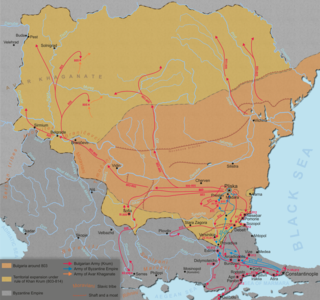
The 8th century is the period from 701 through 800 (DCCC) in accordance with the Julian Calendar.
The 800s decade ran from January 1, 800, to December 31, 809.
The 810s decade ran from January 1, 810, to December 31, 819.
The 830s decade ran from January 1, 830, to December 31, 839.
The 780s decade ran from January 1, 780, to December 31, 789.

Year 842 (DCCCXLII) was a common year starting on Sunday of the Julian calendar, the 842nd year of the Common Era (CE) and Anno Domini (AD) designations, the 842nd year of the 1st millennium, the 42nd year of the 9th century, and the 3rd year of the 840s decade.
The 900s decade ran from January 1, 900, to December 31, 909.

Year 806 (DCCCVI) was a common year starting on Thursday of the Julian calendar, the 806th year of the Common Era (CE) and Anno Domini (AD) designations, the 806th year of the 1st millennium, the 6th year of the 9th century, and the 7th year of the 800s decade.

Year 803 (DCCCIII) was a common year starting on Sunday of the Julian calendar.

Year 781 (DCCLXXXI) was a common year starting on Monday of the Julian calendar. The denomination 781 for this year has been used since the early medieval period, when the Anno Domini calendar era became the prevalent method in Europe for naming years.

Year 782 (DCCLXXXII) was a common year starting on Tuesday of the Julian calendar, the 782nd year of the Common Era (CE) and Anno Domini (AD) designations, the 782nd year of the 1st millennium, the 82nd year of the 8th century, and the 3rd year of the 780s decade. The denomination 782 for this year has been used since the early medieval period, when the Anno Domini calendar era became the prevalent method in Europe for naming years.

Year 785 (DCCLXXXV) was a common year starting on Saturday of the Julian calendar. The article denomination 785 for this year has been used since the early medieval period, when the Anno Domini calendar era became the prevalent method in Europe for naming years. It is still used today in this manner.

Year 786 (DCCLXXXVI) was a common year starting on Sunday of the Julian calendar, the 786th year of the Common Era (CE) and Anno Domini (AD) designations, the 786th year of the 1st millennium, the 86th year of the 8th century, and the 7th year of the 780s decade. The denomination 786 for this year has been used since the early medieval period, when the Anno Domini calendar era became the prevalent method in Europe for naming years.
Year 909 (CMIX) was a common year starting on Sunday of the Julian calendar.

Abū Jaʿfar Hārūn ibn Muḥammad ar-Rāshīd, or simply Hārūn ibn al-Mahdī, famously known as Hārūn ar-Rāshīd, was the fifth Abbasid caliph of the Abbasid Caliphate, reigning from September 786 until his death in March 809. His reign is traditionally regarded to be the beginning of the Islamic Golden Age. His epithet al-Rashid translates to "the Orthodox", "the Just", "the Upright", or "the Rightly-Guided".

Abū ʿAbd Allāh Muḥammad ibn ʿAbd Allāh al-Mahdī, better known by his regnal name al-Mahdī, was the third Abbasid Caliph who reigned from 775 to his death in 785. He succeeded his father, al-Mansur.
Al-Khayzuran bint Atta was the wife of the Abbasid Caliph Al-Mahdi and mother of both Caliphs Al-Hadi and Harun al-Rashid. She maintained de facto influence from 775 to 789 during the reign of her husband and sons and is known for her immense influence on state affairs.

Yahya ibn Khalid was the most prominent member of the Barmakid family, serving as provincial governor and all-powerful long-time vizier to Caliph Harun al-Rashid before his abrupt fall in 803.
Abbasa bint al-Mahdi was a famous Abbasid princess. She was the daughter of Abbasid caliph al-Mahdi, sister of caliph Musa al-Hadi and Harun al-Rashid.










